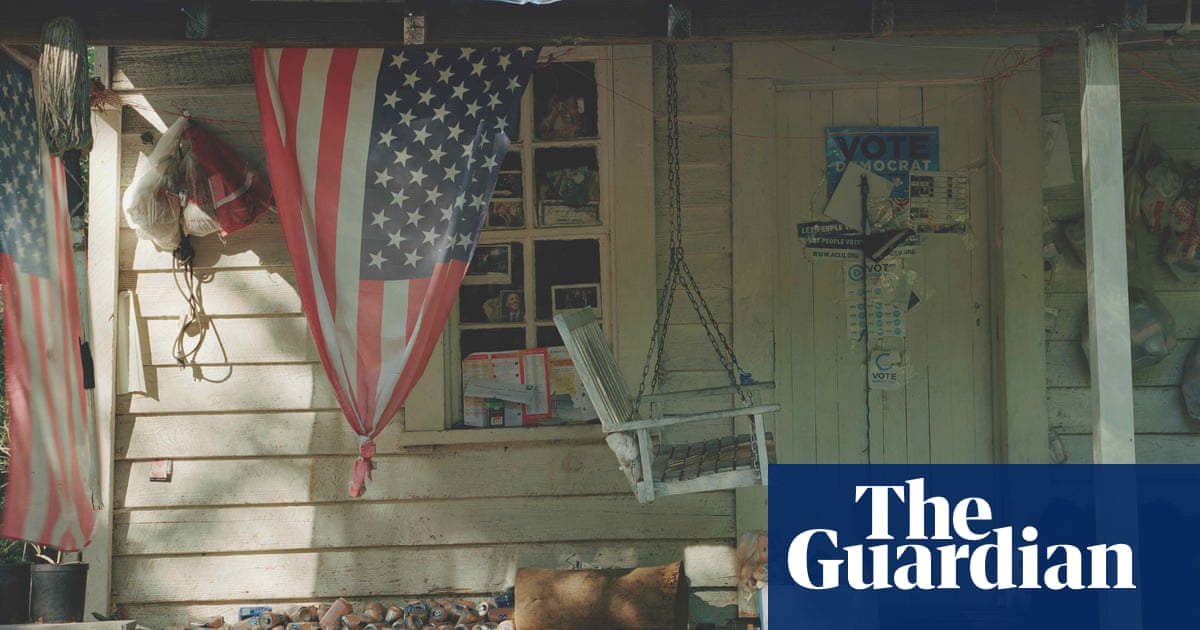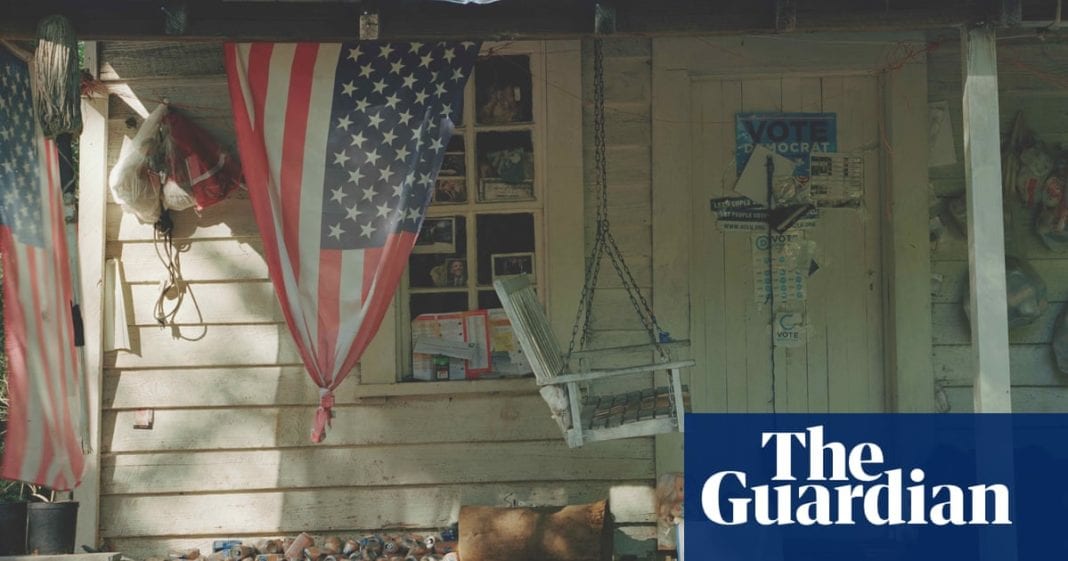From lynching and slavery to the civil rights movement, Alabamas artists expressed the momentous events they lived through as a landmark new exhibition reveals

The quilters of Gee’s Bend make art out of recycled cloth. Lonnie Holley crafts sculptures out of car tyres and other human detritus. Self-taught luthier Freeman Vines carves guitars out of wood that came from a “hanging tree” once used to lynch black men. The “yard shows” of Dinah Young and Joe Minter are permanent exhibitions of their art – a cacophony of “scrap-iron elegies”. Almost all of this art comes from Alabama, and it all features in We Will Walk, Turner Contemporary’s groundbreaking new exhibition of African-American art from the southern state and its surroundings.
Made from found and recycled material, this is art truly from the margins. It’s from places such as Gee’s Bend, the segregated hamlet now known as Boykin, where Martin Luther King travelled in 1965, taking his message about the importance of voter registration. Despite its humble materials, it has echoes of another Alabama son, the jazz band leader and philosopher Sun Ra, and his Afrofuturist message about his own interstellar origins and otherworldly black excellence.
Cultural critic Greg Tate describes the artists in We Will Walk as “southern black visionaries and homegrown technicians of the sacred” who deal in “neo-hoodoo imaginations and hollering bebop ghosts … folks who made ritual look like interior decorating”, and “turned lawn ornamentation into a form of incantation”. That esoteric mix is seen in the work of Minter, which includes a large recreation of the jail cell in Birmingham, Alabama, where King was held after an anti-segregation protest – here, it’s watched over by six concrete dobermans.
It is also discernible in Holley’s Him and Her Hold the Root, a sculpture made up of two rocking chairs with a sprawling root draped across them, and in Ralph Griffin’s Eagle, a wooden rendering of a bald eagle created from found materials. But however otherworldly the work may look, much of it has deep roots in the US civil rights struggle. “These artists were surrounded by momentous events and those events shaped their art,” says curator Hannah Collins.
“My grandmother helped dig the graves for three of the little girls who were in the 16th Street Baptist Church bombing,” Holley tells me, referring to the 1963 terrorist attack in Birmingham, which killed four black girls and stunned the country. “This is how close we were to what you call the political meaning of our existence. We lived in it in Birmingham.”
Holley’s work tells a secret history of black America, one that needs an Enigma machine to decode. A celebrated musician still playing and making albums, he began making art in 1979 when he created an improvised gravestone for his niece and nephew who were killed in a house fire. Two years later, his work was included in a group show of Appalachian art at the Smithsonian, in Washington DC.
His life story is remarkable and horrifying. One of 27 children, he picked cotton, had little formal education and ended up at what was then the Alabama Industrial School for Negro Children in Mount Meigs after breaking a curfew set by Eugene “Bull” Connor, Birmingham’s notorious segregationist commissioner of public safety.
“In a more just world, someone like Lonnie Holley would have been Michelangelo,” says Matt Arnett, son of William Arnett, the art collector and curator who played a key role in bringing Alabama art to the world’s attention. “But he was born black in America in the south, so instead of his intelligence and outlook being revered, celebrated and nurtured, he’s beaten and thrown in a chain gang for children at 11.” Holley would eventually leave Alabama and move in with one of his brothers in Florida, where he worked at Disney World.
Minter’s works stand in the African Village in America, a multi-acre open-air gallery in front of his house – images of it will greet visitors to the Turner exhibition. Continuing the tradition of the “yard show”, where artists would arrange their sculptures on their property, it’s one of the last of its kind. Holley’s own yard show, which he called The Environment, was disassembled when his property was redeveloped as part of an airport expansion. He now lives in Atlanta.
The yard show’s roots are found in slavery – in 1819, slaves accounted for more than a third of Alabama’s population. “Yards were traditionally a space of music and artistic practice, the only place for creativity for centuries,” says Collins.
Vines’ work is similarly rooted in the black southern experience. He talks about the lynchings he remembers as a boy, including one of a man in his 80s who was dragged behind a truck after being accused of exposing himself to two white women. The connection isn’t just via memory, it is physical, too. Vines remembers buying wood for his guitars from a timber merchant. “He said, ‘You might not want that wood there. Black men were hung on that tree.’ Then we researched the young men who were killed on that tree. I felt the wood was trying to talk to me, trying to tell me something.” It’s that tangible, horrific link between the artists and America’s recent past that We Will Walk taps into.
To fully grasp We Will Walk you need to understand the blues, according to Collins. Like the tortured, lovelorn and agonised songs that rang out from below the Mason-Dixon line and morphed and mutated into rock’n’roll – to be consumed by a white audience largely ignorant of its black origins – the Alabama art echoes throughout the work of celebrated white artists, including Jasper Johns and Robert Rauschenberg.
“If you look at a Rauschenberg, there’s a conversation going on, but it’s clearly one-sided,” says the curator. “The same is true for Johns – it’s all about hidden things. They exported that language in a similar way to the blues. It’s like a lot that comes from the south: it’s been exported but not with credit. This is a chance to redress that balance.”
That artistic lineage is also there in the work of contemporary AfricanAmerican artists such as Mark Bradford, who uses discarded advertising hoardings to create his large-scale abstract works, and Rashid Johnson’s Broken Men series made with oil sticks, melted black soap, wax and flooring. “All the art in the show is pre-made or from existing materials, it’s about materials but it’s also about using what you have and not using up resources from the world,” says Collins.
While Holley, Minter, Thornton Dial, Purvis Young and Joe Light from Memphis have received some recognition, the work of black female artists has largely been ignored. “Some of the men have had careers as artists, but for the women we don’t know about them,” says Collins. “The women stayed in the yards.”
Nonetheless, there were of course female artists in the south. Dinah Young and Emmer Sewell’syard art– the latter using plastic chairs and twigs – is represented in the show, as are the quilters of Gee’s Bend. These groups of women, who made large, complex patchwork blankets, took decades to receive recognition, finally getting exhibitions in Houston and at the Whitney in New York.
Louisiana Bendolph, a quilter and visual artist, says when she visited a quilt exhibition in Houston in 2002 she hid among the audience, concealing her name tag under her jacket – eavesdropping to hear their take on the work.
One young man, a trainee architect, stands out in her memory. He was amazed that there was often a symmetry to the work despite its construction from cast-off cloth. “He saw art,” says Bendolph, whose mother-in-law Mary Lee Bendolph is a Gee’s Bend quilter. “He was amazed by the work and how the pieces balanced themselves out. A lot of the quilts had been used, and people would see a little stain and realise this is somebody’s life: someone slept on them, other people might have died on one.”
The quilts and the lives they enfolded have been exhibited all over the US, and have now travelled 4,400 miles from Gee’s Bend to Margate on the Kent coast. It is the first time that most of this art will have been seen in the UK and visitors will be looking at an art form that is fading. Many of its practitioners have died, and the world they grew up in has gone or been replaced with a more modern form of segregation. “Lonnie has lived long enough to see his genius recognised,” says Arnett. “But so many people who came from the culture Lonnie did never got a chance to see that.”
For Collins, the art is an antidote to the frustration of modern politics and social life, a way to see how channelling anger can be positive and how art can move beyond commodification. “There’s protest, but we don’t really know how to make that effective,” she says. “There’s an art world that is removed from everyday life – it’s the making of objects for the uber-rich. I think this work is the opposite of that.”
-
We Will Walk: Art and Resistance in the American South is at Turner Contemporary, Margate, from 7 February until 3 May.
Read more: www.theguardian.com









![[Video] How to get rid of bed bugs in Toronto](https://www.thehowtozone.com/wp-content/uploads/2019/10/maxresdefault-2-100x70.jpg)


